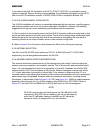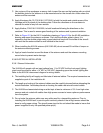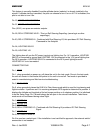B KLN 94
Rev. 4, Jan/2003 10599I04.CDL Page 2-1
SECTION II
INSTALLATION
2.1 GENERAL INFORMATION
This section contains general suggestions and information to consider before installation of the
KLN 94 GPS RNAV. Close adherence to these suggestions will assure optimum performance
from the equipment.
NOTE
For aircraft equipped with a KLN 89B that is being replaced by a
KLN 94 refer to Appendix D, Direct Replacement of a KLN 89B with
a KLN 94, at the end of this manual.
NOTE
The conditions and tests required for TSO/JTSO approval of this
article are minimum performance standards. It is the responsibility
of those desiring to install this article either on or within a specific
type or class of aircraft to determine that the aircraft installation
conditions are within TSO/JTSO standards. The article may be
installed only if further evaluation by the applicant documents an
acceptable installation and is approved by the Administrator.
2.2 UNPACKING AND INSPECTING EQUIPMENT
Exercise extreme care when unpacking the equipment. Make a visual inspection of the unit for
evidence of damage incurred during shipment. If a claim for damage is to be made, save the
shipping container to substantiate the claim. The claim should be promptly filed with the
transportation company. It would be advisable to retain the container and packaging material
after all equipment has been removed in the event that equipment storage or reshipment should
become necessary.
2.3 EQUIPMENT INSTALLATION
2.3.1 AVIONICS COOLING REQUIREMENTS FOR PANEL MOUNTED EQUIPMENT
The greatest single contributor to increased reliability of all modern day avionics is to limit the
maximum operating temperature of the individual units whether panel mounted or remote
mounted. While modern day individual circuit designs consume much less electrical energy,
watts per cubic inch dissipated within the avionics unit remains much the same due to the high
density packaging techniques utilized. Consequently, the importance of providing cooling to the
avionics stack is still with us today.
While each individual unit may or may not require forced air cooling, the combined heat load of
several units operating in a typical avionics location will significantly degrade the reliability of the
avionics if provisions for cooling are not incorporated in the initial installation. Failure to provide
cooling to the equipment will lead to increased avionics maintenance costs and may also void the
Honeywell warranty.


















